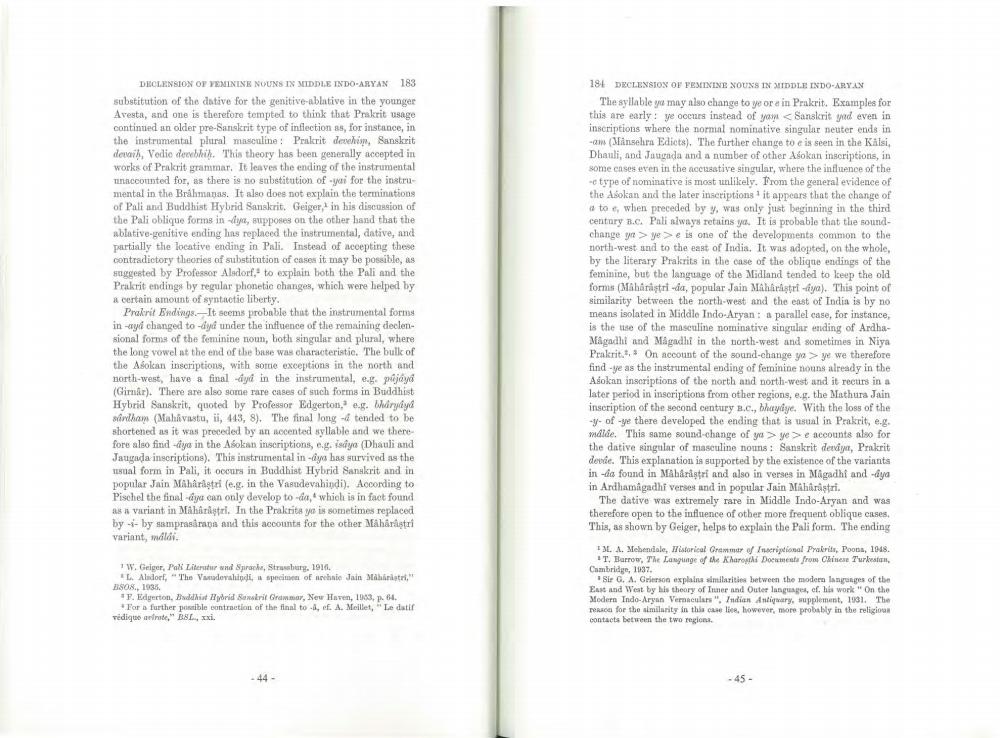________________
DECLENSION OF FEMININE NOUNS IN MIDDLE INDO-ARYAN 183
substitution of the dative for the genitive-ablative in the younger Avesta, and one is therefore tempted to think that Prakrit usage continued an older pre-Sanskrit type of inflection as, for instance, in the instrumental plural masculine: Prakrit devehi, Sanskrit devaiḥ, Vedic decebhih. This theory has been generally accepted in works of Prakrit grammar. It leaves the ending of the instrumental unaccounted for, as there is no substitution of -yai for the instrumental in the Brahmanas. It also does not explain the terminations of Pali and Buddhist Hybrid Sanskrit. Geiger, in his discussion of the Pali oblique forms in -dya, supposes on the other hand that the ablative-genitive ending has replaced the instrumental, dative, and partially the locative ending in Pali. Instead of accepting these contradictory theories of substitution of cases it may be possible, as suggested by Professor Alsdorf, to explain both the Pali and the Prakrit endings by regular phonetic changes, which were helped by a certain amount of syntactic liberty.
Prakrit Endings. It seems probable that the instrumental forms in -ayd changed to-dyd under the influence of the remaining declensional forms of the feminine noun, both singular and plural, where the long vowel at the end of the base was characteristic. The bulk of the Asokan inscriptions, with some exceptions in the north and north-west, have a final dyd in the instrumental, e.g. pújaya (Girnår). There are also some rare cases of such forms in Buddhist Hybrid Sanskrit, quoted by Professor Edgerton, e.g. Wháryây sardham (Mahavastu, ii, 443, 8). The final long - tended to be shortened as it was preceded by an accented syllable and we there fore also find -dya in the Asokan inscriptions, e.g. isaya (Dhauli and Jaugada inscriptions). This instrumental in -dya has survived as the usual form in Pali, it occurs in Buddhist Hybrid Sanskrit and in popular Jain Mähârăştri (e.g. in the Vasudevahindi). According to Pischel the final -dya can only develop to -da, which is in fact found as a variant in Mahârâştri. In the Prakrita ya is sometimes replaced by -i- by samprasarana and this accounts for the other Maharastri variant, máli.
1 W. Geiger, Pali Literatur und Sprache, Strassburg, 1916.
L. Alsdorf, "The Vanaderahindi, a specimen of archaic Jain Mähärästi," BSOS., 1935.
F. Edgerton, Buddhist Hybrid Sanskrit Grammar, New Haven, 1963, p. 64. *For a further possible contraction of the final to -a, ef. A. Meillet, "Le datif védique artrate," BSL, xxi.
184 DECLENSION OF FEMININE NOUNS IN MIDDLE INDO-ARYAN
The syllable ya may also change to ye or e in Prakrit. Examples for this are early: ye occurs instead of you <Sanskrit yad even in inscriptions where the normal nominative singular neuter ends in -am (Mansehra Edicts). The further change to e is seen in the Kälsi, Dhauli, and Jaugada and a number of other Asokan inscriptions, in some cases even in the accusative singular, where the influence of the -e type of nominative is most unlikely. From the general evidence of the Asokan and the later inscriptions it appears that the change of a toe, when preceded by y, was only just beginning in the third century a.c. Pali always retains ya. It is probable that the soundchange ya ye>e is one of the developments common to the north-west and to the east of India. It was adopted, on the whole, by the literary Prakrits in the case of the oblique endings of the feminine, but the language of the Midland tended to keep the old forms (Maharastri-da, popular Jain Mâhârâştri -aya). This point of similarity between the north-west and the east of India is by no means isolated in Middle Indo-Aryan: a parallel case, for instance, is the use of the masculine nominative singular ending of ArdhaMagadhi and Magadhi in the north-west and sometimes in Niya Prakrit. On account of the sound-change yo> ye we therefore find -ye as the instrumental ending of feminine nouns already in the Asokan inscriptions of the north and north-west and it recurs in a later period in inscriptions from other regions, e.g. the Mathura Jain inscription of the second century B.c., bhayaye. With the loss of the -y-of-ye there developed the ending that is usual in Prakrit, e.g. malde. This same sound-change of ya> ye> e accounts also for the dative singular of masculine nouns: Sanskrit devaya, Prakrit devie. This explanation is supported by the existence of the variants in -da found in Mähäräştri and also in verses in Magadhi and -aya in Ardhamagadhi verses and in popular Jain Mähârâştri.
The dative was extremely rare in Middle Indo-Aryan and was therefore open to the influence of other more frequent oblique cases, This, as shown by Geiger, helps to explain the Pali form. The ending
M. A. Mehendale, Historical Grammar of Inscriptional Prakrits, Poona, 1948. T. Barrow, The Language of the Kharostki Documents from Chinese Turkestan, Cambridge, 1937.
Sir G. A. Grierson explains similarities between the modern languages of the East and West by his theory of Inner and Outer languages, ef. his work " On the Modern Indo-Aryan Vernaculars". Indian Antiquary, supplement, 1931. The reason for the similarity in this case lies, however, more probably in the religious contacts between the two regions.
-45




